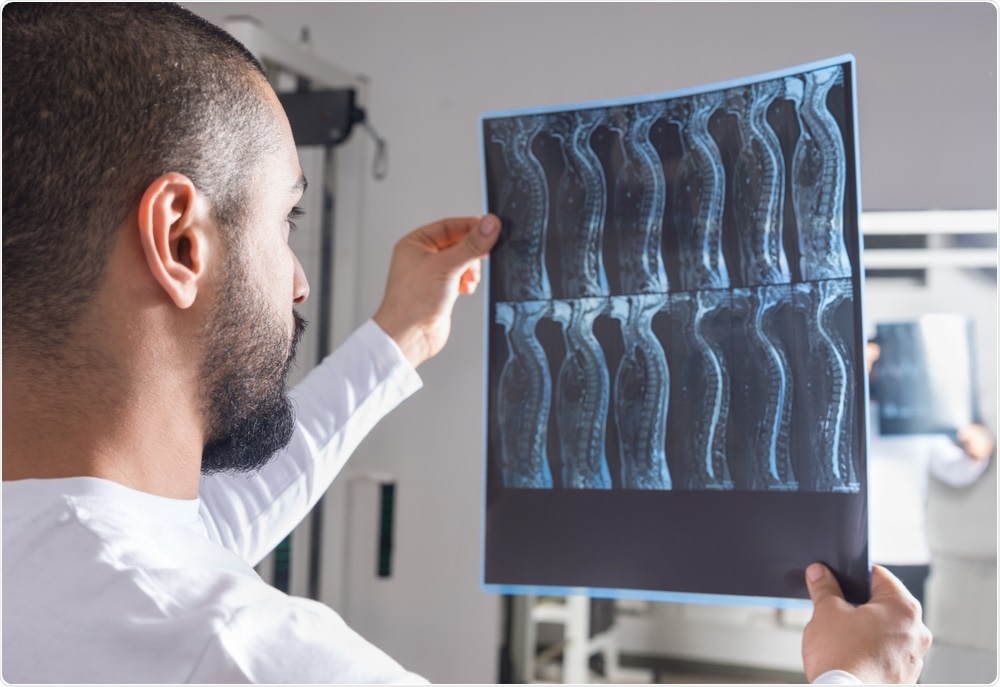Senescent cells prevent tissue recovery following spinal cord injury, and a new drug targeting these cells could therefore improve functional recovery capacity.

Spinal Cord Injury. Image Credit: Viacheslav Nikolaenko/Shutterstock.com
Exploring treatments for spinal cord injury in animal models
Notorious for having a poor ability to recover from spinal cord injuries, mammals often suffer from whole-body paralysis following such recoveries. This contrasts to other taxonomic groups, such as fish, that can recover from injury relatively rapidly in comparison.
One of the main reasons that mammals succumb to such extensive damage and are unable to functionally recover following spinal cord injury is the formation of a complex scar associated with chronic inflammation that produces a cellular microenvironment blocking tissue repair.
Despite the importance of understanding the underlying mechanisms and causation of such cellular response that is key to improving the recovery and treatment of spinal cord injuries, information on the exact cellular mechanisms at work remains elusive.
To address this gap in clinical knowledge, a research team led by Leonor Saude, a leader at Instituto de Medicina Molecular Joao Lobo Antunes (iMM; Portugal) and Professor at Faculdade de Medicina da Universidade de Lisboa, have shown that the administration of drugs that target specific cellular components of this scar, improve functional recovery after injury.
The study was published in the scientific journal Cell Reports, and its findings may extend beyond spinal cord injuries to the treatment of other organ-related injuries that lack regenerative competence.
Leonor Saude and her team conducted the study at iMM with collaboration from researchers at CEDOC NOVA Medical School and was funded by "la Caixa" Foundation – Caixa Research Call and Fundacao para a Ciencia e a Tecnologia (Portugal).
In the past, the research group has studied spinal cord injury and scar formation using two different models; zebrafish, which can recover rapidly from a spinal injury, and mammals, which characteristically exhibit poor recovery.
In mammals, upon spinal cord injury, researchers observed that cells start to accumulate at the lesion periphery. But not just any cells: "These cells are known as senescent cells. They have specific features and markers and are what we can call "zombie cells", where growth and division are interrupted, but where the normal cell death program is not activated", explains Leonor Saude. "While in zebrafish, the accumulation of these cells at the injury periphery is cleared out over time, in mammals, these cells persist and are important components of the dense scar observed.
Since senescent cells have distinct and identifiable molecular markers, specific drugs can be tested to inhibit or eliminate them.
With the administration of different senolytic drugs, that specifically target these senescent cells, we have observed a progressive decrease of these cells, a decrease in the scar extension, and lower levels of inflammation due to a decreased secretion of pro-fibrotic and pro-inflammatory factors. The observed changes at the molecular level underlie the improved locomotor, sensory and bladder functions that we have also found".
Isaura Martins
Outlook and implications of potential treatment
With the improved recovery capacity following the administration of senolytic drugs targeting the senescent cells, the researchers, therefore, showed that spinal cord injury could be treated effectively and rapidly by using in vitro trials on mammal animal models.
By improving the recovery capacity of individuals, it is, therefore, possible to functionally treat particularly severe injuries. This treatment method can also be extended beyond only spinal injuries to treat organs that exhibit a similarly limited capacity to recover following injury.
However, further data requires to be collected and tested. Future studies could refine the choice of senolytic treatments as well as consider the long-term or secondary effects of treatments across more animal models. Treatments may also be paired with other drugs, such as anti-inflammatory agents to further achieve a full functional recovery.
Nevertheless, the findings of this study provide key insight into the mechanisms involved in cellular reparation and provide valuable physiological information that can be expanded in future research.
Although we are still far from healing spinal cord injuries in humans, we are learning more about the molecular signatures of these lesions and these new promising results can open new therapeutic strategies that can be applied not only to spinal cord injuries but in other conditions that lack regenerative competence"
Leonor Saude
Journal reference:
- Diogo Paramos-de-Carvalho*, Isaura Martins*, Ana Margarida Cristóvão, Ana Filipa Dias, Dalila Neves-Silva, Telmo Pereira, Diana Chapela, Ana Farinho, António Jacinto, Leonor Saude. (2021) Targeting senescent cells improves functional recovery after spinal cord injury. Cell Reports. http://dx.doi.org/10.1016/j.celrep.2021.109334